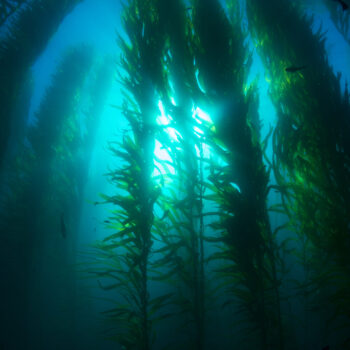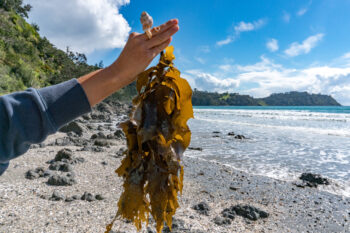If you’ve walked along a beach or explored a rocky shore, you’ve likely seen lots of seaweed. It grows naturally along our coasts, most visible at low tide. You might even see a series of buoys offshore that mark a farm where strands of sugar kelp hang down from long ropes. And if you live in certain coastal communities, you may have seen it on a local restaurant menu.
It’s being prepared in everything from ice cream to gin drinks. It can be blanched, braised, steamed, or dried and ground up into a powder. There are hundreds of variants, each with its own unique taste and color.
Seaweed’s popularity is growing beyond tidal pool discovery into a culinary art form and home kitchen curiosity and exploration.
There’s a good reason for this: Seaweed is an exceptionally nutritious food. It is rich in vitamins A, B, C, D, E, and K, as well as dietary fiber, Omega 3s and important amino acids. It does not require the industrial inputs of land-based conventional crops like water, fertilizer, and excess nitrogen or phosphorus. It packs high nutrition per gram.
Left untouched, kelp forests harbor entire ecosystems of marine life, including everything from tiny plankton to sea otters scouring the ocean bottom for tasty molluscs to crack open with rocks they carry tucked under their arms. And research suggests that these kelp forests store significant amounts of carbon, much like a concentrated antidote to climate change. It also takes in nitrogen and phosphorous, frequent byproducts of land-based fertilizer use.
According to the United Nations Food and Agriculture Organization, the U.S. produced almost 3,394 tons of wet weight kelp, both farmed and wild harvested, in 2019. About 85% of the country’s kelp production in 2021 came from Maine.
I’ve spoken to several Northeast chefs who are incorporating various types of seaweed on their menus. One common theme for them is how much they appreciate working directly with local producers. Not only does this mean they are close to the area where the seaweed grows, but they learn more intimately about the seaweed lifecycle, seasonality and its role in local ecosystems. They also learn how each producer handles the product.
This is important as we think of Slow Fish and Slow Food values along the supply chain. Direct relationships between chefs and producers, as well as between consumers and producers are foundational to food systems that are good, clean and fair. And if we as consumers can’t always meet seaweed producers, learning the story of how and where the seaweed was grown, and perhaps a bit about its seasonality and role in local ecosystems, is essential.
Some of the seaweed showing up more frequently in Northeast restaurants includes sugar kelp (which was recently nominated to the Slow Food Ark of Taste) and skinny kelp (a variant of sugar kelp), dulse and sea lettuce. Bull kelp, winged kelp, and sugar kelp are popular on the west coast.
Several folks in and around the Slow Fish North America network either grow seaweed or harvest it in the wild.
- Severine Von Tscharner Welcome runs Smithereen Farm with her partner Terran in Pembroke, Maine, where they grow or wild harvest sugar kelp, winged kelp, dulse, and a host of land produce including Maine blueberries.
- Dune Lankard, is an Eyak Athabaskan former salmon fisherman-turned-seaweed farmer and entrepreneur in Cordova, Alaska. He founded the Native Conservancy to protect and restore Alaska Native ecosystems for coastal communities. Native Conservancy provides seaweed aquaculture opportunities for coastal Indigenous communities.
- Amanda Swinimer runs Dakini Tidal Wilds in British Columbia and wild harvests a variety of seaweeds, including bull and winged kelp, for sale.
Generally, responsible aquaculture centers on small-scale, community-focused bivalve and seaweed farms (often called mariculture), and aquaponics (typically raising herbivorous fish and leafy greens like lettuce in closed, land-based systems) that operate in harmony with local ecosystems and serve surrounding communities. This means minimizing ecological impact, knowing how to grow and harvest seaweed, and not substantially altering the biodiversity of the marine ecosystem.
This also means honoring and restoring the subsistence relationships that indigenous cultures have had with coastal seaweed in their communities since time immemorial. After all, we can learn much about living in harmony with natural food systems from such practices.
Severine and Amanda collaborated with a team of seaweed harvesters and seafood advocates in 2022 on the Seaweed Commons, a position paper advocating for a common sense approach to seaweed aquaculture in the face of pressure to scale up rapidly and mass produce kelp either as a thickening agent in food processing or as a source for biofuel industry.
And as Severine often says, we should be treating seaweed and kelp as more of a specialty produce that adds complementary flavor, even as a condiment, rather than being the center of the dish.
We should absolutely be trying seaweed in restaurants and learn more about local harvesters and what they harvest. Kelp butter with grilled oysters, anyone?
But we should be doing this in a thoughtful way, honoring how special seaweed is on so many fronts. And we should take the time to learn where the seaweed we eat comes from to ensure that it truly is good, clean and fair.
Top photo via Wikipedia







